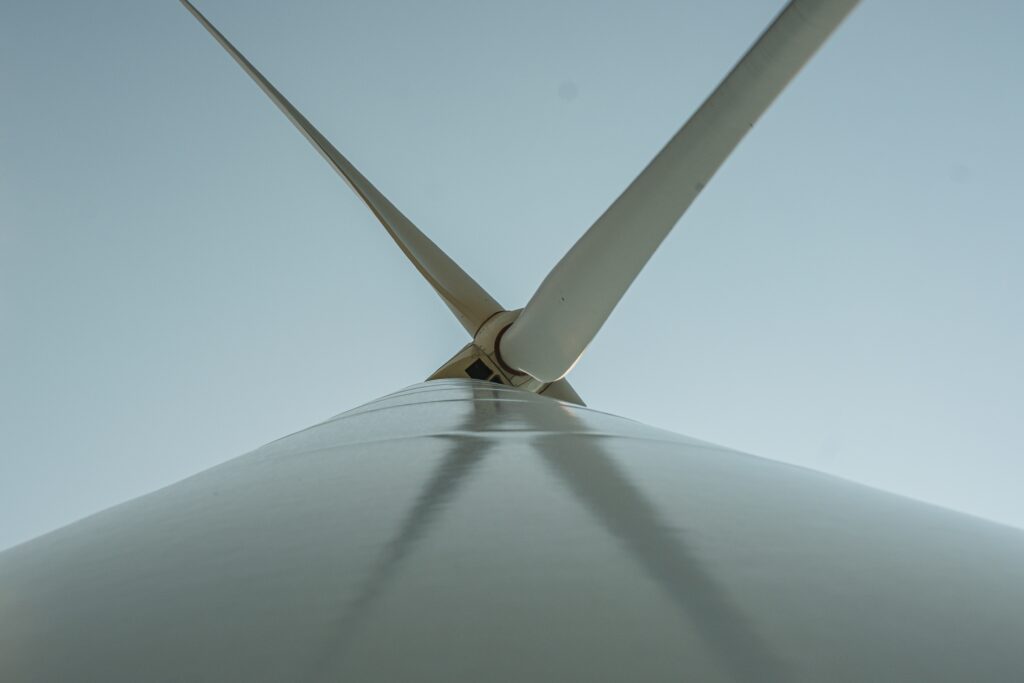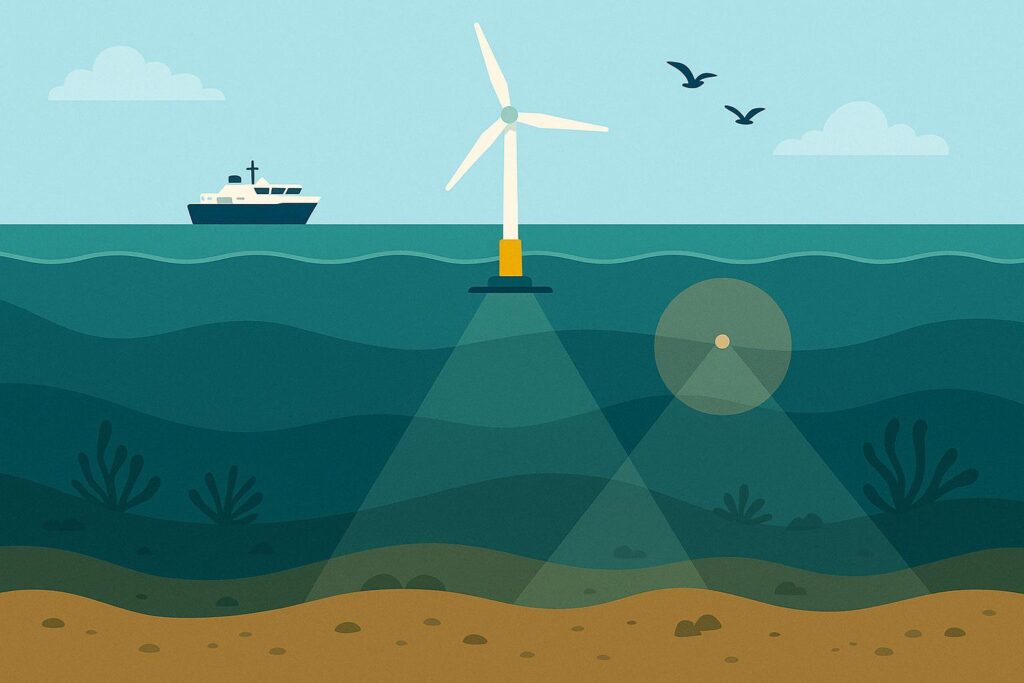The offshore wind industry has emerged as a key player in the renewable energy revolution. As governments are ramping up developments and funding to meet climate targets, offshore wind farms are popping up across global coastlines.
With this growth comes the inevitable question: how does the expansion of offshore developments impact the health of marine ecosystems? Offshore renewable energy developments haven’t always prioritised the protection of ocean species, but the key to future success is striking the balance.

By leveraging technological innovations, robust regulatory frameworks, and a collaborative approach, we can work towards developing offshore wind farms that deliver clean energy while still protecting marine species and ecosystems.
What risks do offshore wind farm developments pose to marine ecosystems?
If offshore wind energy is going to be a cornerstone of global efforts towards a clean energy transition, then valid concerns regarding potential environmental risks and trade-offs have already been raised. To protect marine ecosystem stability and benefit the most from the potential of offshore wind energy, understanding these risks is essential for developments and operations.
Habitat disruption and species displacement
Installing offshore wind farms involves heavy construction activities: seabed drilling, pile driving, and dredging.
Each of these activities can damage or destroy marine habitats, and directly affect plants, crustaceans, and fish that inhabit the local area. Marine mammals, particularly cetaceans, are also vulnerable, as construction noise can interfere with their communication, navigation, and feeding behaviours.
Sediment disturbance and effects to water quality
Disrupting the seabed sediment during offshore site construction can have far-reaching effects for marine habitats. Suspended particles immediately reduce water clarity, affecting photosynthesis for the local marine plants and coral species. Filter feeders like mussels and oysters can also struggle in sediment-heavy waters.
These impacts are relatively short-term compared to others, and with improved site selection and phased construction approaches, developers are already working to minimise prolonged disturbances.
Fisheries and food chain disruptions
The fishing industry has raised concerns about offshore wind farms restricting access to fishing grounds, potentially impacting livelihoods.
There is also ongoing research into whether electromagnetic fields from subsea cables affect fish behaviour. Some studies suggest minimal disruption, while others indicate certain species may avoid cable areas altogether.
Seabird collisions
For seabirds, wind turbines present a new aerial obstacle – this is, obviously, not great for the birds. It’s long been observed that species that soar or dive near offshore wind farms face a collision risk, particularly when turbines are built in high-traffic migratory corridors.
However, evidence suggests that strategic turbine placement and adjusted blade speeds can significantly lower collision rates. Technological advancements such as bird detection radar are also now being explored to help mitigate these risks in real-time and protect natural migration routes.
Finding the balance?
The risks posed by offshore wind development to marine ecosystems are real but not insurmountable. With a proactive approach to planning, rigorous environmental assessments, and continuous monitoring, these impacts can start to be addressed.
The key lies in real-world collaboration – the bringing together of policymakers, conservationists, and industry leaders to ensure that offshore wind can coexist with thriving marine ecosystems.
How can emerging innovations in green technologies turn conflict into collaboration?
So, as offshore wind farms expand across coastal horizons, valid concerns about their impact on marine ecosystems remain an essential discussion point. There are ways to address each of these concerns – but who says it needs to be a conflict at all?
Rather than being an unavoidable conflict, dedicated researchers and industry leaders have been working towards an evolution that actively supports the health of ocean waters and ecosystems.
The focus so far has largely been on three key areas:
- Improved turbines foundations: Bio-friendly coatings, varied surface textures, and artificial reef structures
- Lowering noise pollution levels: Advanced installation and operational methods.
- Eco-focused site planning: Placing sites to the benefit of local marine ecosystems.
Traditional wind turbine bases have been engineered purely for functionality, but newer designs are working to incorporate ecological benefits that are designed to encourage marine biodiversity, and transform turbines into thriving marine habitats. Floating offshore wind farms may also provide less intrusion into marine habitats. In several locations, these adaptations have already led to an increase in marine life, with fish, shellfish, and corals all using turbine foundations as new ecological niches.
Noise pollution is another critical issue in offshore wind development, particularly during construction. Underwater noise from pile driving and drilling can disrupt marine mammals, affecting their ability to communicate and navigate. Bubble curtains – air barriers that naturally reduce noise transmission in water – are increasingly being used to address this, alongside alternative installation methods such as quieter vibratory piling and suction bucket foundations.
With renewed focus in recent years on habitat conservation, developers are increasingly expected to consider marine ecosystems in offshore wind farm planning, construction, and operations. In some cases, wind farms are being deliberately integrated into marine spatial planning efforts, with their restricted-access zones serving as designated conservation areas to enhance biodiversity protection. By their nature, wind farms limit industrial fishing in their immediate surroundings, creating pockets of reduced human activity where ecosystems can rebuild and thrive!
Why AI is shaping the future of offshore wind farms
Emerging AI technologies are already shaping countless industries, in ways we don’t always expect – and when it comes to the future of AI offshore wind farm development it’s all about smart data processing.
Many may not realise that AI has already been used in certain wind turbine designs for condition monitoring, giving operators a better understanding on real-time local conditions and optimised maintenance schedules. But AI advancements mean we can now simulate local conditions, whether that’s counting and measuring boulders on the seabed, or modelling historical weather patterns, allowing developers to understand each stage of the project life cycle.
AI-powered siting strategies can help minimise ecological disruption during construction and operations; and provide developers with an insight into local conditions and shipping routes (helping to pinpoint and mitigate any issues that may arise with the site).
Where manual site assessments and planning are time-intensive and are open to human error, processing big data with AI means developers can understand the potential risks in, and long-term ecological effects to, proposed offshore wind farm sites.
High-resolution, data-driven offshore site assessments are the future of wind farm development – giving developers, policymakers, and consultants, a direct insight into prospective sites much quicker and with better accuracy.

The role of policy and regulation in balancing offshore wind energy generation and marine ecosystems
As with all other rapidly expanding industries, the growth of offshore wind energy development will need to be accompanied by robust and reliable regulation. We all want cleaner energy, but ideally (and essentially) with protected marine ecosystems and a focus on bio-friendly technologies.
Without a strong regulatory framework, the risks of habitat disruption, biodiversity loss, and ecosystem instability increase. However, with clear policies and adaptive management strategies, offshore wind can be developed in a way that supports both energy security and environmental sustainability.
One of the most important regulatory tools in this space is Marine Spatial Planning (MSP), which helps identify suitable areas for offshore wind farms while avoiding ecologically sensitive zones. Adhering to MSP means offshore wind farms are developed (and operate) with minimal disruption to marine biodiversity and existing maritime industries.
Ensuring offshore wind farms adhere to IEC standards, is critical for safety, efficiency, and environmental sustainability. These international guidelines help developers design and operate turbines that withstand marine conditions while minimising ecological impact. Compliance with IEC standards also supports regulatory approvals and enhances long-term operational reliability.
While the industry develops, so too must the regulations and policies that are in place.
Different states and International bodies have approached offshore wind regulation with varying levels of success, and static policies are unlikely to address the complex, ever-changing relationship between offshore wind and marine ecosystems.
Real-time environmental monitoring and flexible policy adjustments are crucial for minimising long-term ecological risks. But with strong policies in place, offshore wind can prove to be a model for responsible renewable energy development.
Offshore wind and marine conservation: the necessary partnership
Offshore wind farms are often framed as an environmental trade-off, but they don’t have to be. With smarter planning, ecological innovation, and strong regulation, offshore wind farms can become more than just clean energy producers – they can actively contribute to the health of marine ecosystems.
The challenge is clear, but so is the opportunity; and as the industry expands, the focus must remain on balancing progress with protection.
Clean energy shouldn’t mean we can’t have clean, healthy oceans.
The future of sustainable energy lies in working with nature, not against it…
Learn more about how AI is evolving green tech and the offshore renewables industry, at the NeuWave blog, or join the conversation on LinkedIn!

